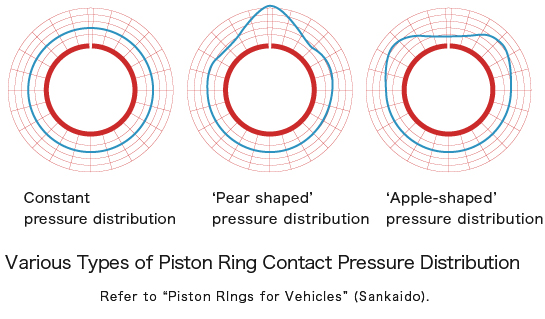Technologies that Assure Ring Function
C-1 Gas Sealability (1)Peripheral Roundness & Bearing Stress
In the installed condition (when the gap *1 is closed), the piston ring must form a circle such that its periphery (running face) contacts the cylinder wall all the way around. This is a critical requirement. If the ring doesn't seal against the cylinder wall, combustion gases will leak to the outside. It's interesting to note that the ring does not press with uniform force all the way around its circumference, from one gap-end to the other. In fact, this contact pressure *2 can be controlled during ring manufacture to guarantee that the desired contact pressure distribution is achieved in the assembled engine. The figures below show how the ring's contact pressure can be different, depending on the particular engine's specific requirements.

The free gap and shape of the ring in its uninstalled condition will determine how much tension is present in the installed ring and which type of pressure distribution is achieved. The ring gap area must be designed to have minimum up and down movement since excessive dynamic movement would result in poor gas sealing characteristics even when the ring has good roundness. The ring designer must consider the specific engine application and then design the ring's free shape and free gap in order to achieve proper ring tension and the desired contact pressure distribution in the installed condition.
- *1 The open part of the ring required for ring installation and to provide the spring force required for ring function.
- *2 Pressure exerted in the direction of the cylinder wall radius






